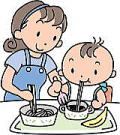Age 2
Children’s Meals (2-3 years)
The fundamentals of mealtime are for your child to get plenty of exercise beforehand so she is hungry, and for adults to join her at the dinner table and eat together in an enjoyable atmosphere.
In order to enjoy meals . . .
 As your child’s sense of taste develops and she becomes able to make subtle distinctions between flavors, she will develop likes and dislikes. As she also becomes able to declare her intentions, she may suddenly announce “I’m not eating this!”, but children’s likes and dislikes are temporary.
As your child’s sense of taste develops and she becomes able to make subtle distinctions between flavors, she will develop likes and dislikes. As she also becomes able to declare her intentions, she may suddenly announce “I’m not eating this!”, but children’s likes and dislikes are temporary.
- Don’t force your child to eat anything.
- Let your child see adults enjoying what they are eating.
- Make meals fun by changing the way food is arranged and the mealtime atmosphere.
- Give your child a little bit of food at a time and let her feel the satisfaction of finishing it.
- Bring out your child’s motivation with magic words.
- Let your child help with simple preparation tasks such as washing or picking vegetables.


Is your child eating too many snacks?
Do you let your child eat snacks before mealtime because she didn’t eat the previous meal and you don’t want to make her wait until the next one? This is also the age when you may be troubled by your child’s requests for snacks.
- Set times for meals and snacks.
- Don’t keep juice, ice cream, etc. in the refrigerator or freezer.
- Make sure an adult manages the area where snacks are stored.
- Limit the amount of milk, fruit, and ionized drinks your child consumes.
If your child isn’t chewing properly . . .
Does your child swallow food without chewing it properly, eat very quickly, or have difficulty chewing meat and fish, storing them up in her mouth? Here’s what you can do.
- Tell your child to put less food in her mouth at once and only take another bite once she has swallowed the last one.
 Serve soup with meals.
Serve soup with meals.- Don’t leave water on the table and let your child get in the habit of washing food down.
 Don’t let your child eat alone. Make sure she eats with an adult who can set a good example.
Don’t let your child eat alone. Make sure she eats with an adult who can set a good example.
Holding a spoon and fork properly
Children are still developing fine motor skills and the ability to hold a spoon and fork properly.
 |
(1)Your child holds utensils in her fist and use them to scoop or stab. |
 |
(2)Your child holds utensils in her fist and uses them to lift up food from below. |
 |
(3)Your child becomes able to hold utensils with her thumb, forefinger, and middle finger. |
 |
(4)Your child is able to hold utensils properly, holding them with her thumb and forefinger and supporting them with the side of her middle finger. |
Once your child is at step (4), she can make a smooth transition to chopsticks.
